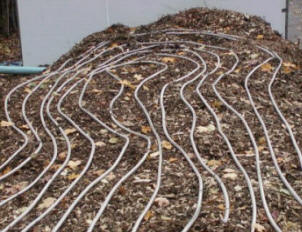This is an email from Marc detailing
the results he achieved and lessons learned from operating his compost pile
furnace over the first full season.
Hi Gary,
Here's the good and the bad to date:
The pile generated ~25,000btu/hr as per the design specification and did so
without turning from the end of Sept. through the end of Dec. maintaining
a 40 deg. F temperature differential between the recirculating water and the
ambient outside temp. For the first month or so of operation, the water
temp was much higher in the 130~140 deg F range. Using Nitrogen fertilizer
granules (urea) to combine with the wood chips worked rather well, but
reapplication was necessary by the end of Dec to maintain the pile. In Jan.
the differential temperature dropped to 30 deg. F and by Feb. dropped
another 5 deg. Further supplement of Nitrogen and/or water or air was
pointless as the pile had gone ostensibly dead by the end of Feb. Total
cost for the Nitrogen granules was ~$300.
Using inexpensive garden hose for the heat exchanger in the pile worked
pretty well (there are 2 300' layers of loops at differing elevations in the
pile independently selectable). The cheap hose is actually better suited to
the purpose due to its thin walls for easy heat exchange. Having hose
traversing the pile makes turning it over impractical. This year I've
placed concentrated reservoirs into the pile for heat exchange to facilitate
turning it over in the spaces around the tanks. To a similar point, the
insulation blanket needs to be in a protective jacket both to avoid fouling
(insects and debris) as well as to keep the moisture out and again to
facilitate easy removal for gaining access to the pile for turning. Pile
access was further impeded by the fencing itself as well as the plastic
sheathing and cover tarp. I incorporated a gate in the sidewall of the pen
for my own access, but of no value when access for heavy equipment is
required. Initially I kept the end wall removed for that purpose.
Regarding aeration, regardless of some disinformation on the web to the
contrary, aeration of the pile is insufficient to sustain combustion - the
pile still needs to be turned over periodically. For my purpose, the
point of forced air pile aeration was to obviate the need for mechanical
intervention to turn the pile. There's no such thing as a free lunch. While
it's possible that the flow rates were insufficient for that purpose,
theoretically the blower, size and number of holes were all calculated to
give the correct cfm through the pile to sustain efficient combustion
(according to those who have studied and quantified the problem). Since the
pile wasn't instrumented I can't actually verify the impact of running the
aeration blower other than by empirical means which seemed to show that
running it without preheating the influent air cooled the pile down and
lowered the water temps during the winter by as much as 10deg F. If I were
to undertake serious development, I would definitely try to preheat the air.
The sprinkler hose used for maintaining moisture wasn't optimal. What would
typically happen is that the top layers of the pile would dry out and the
bottom of the pile would gain excessive moisture. While I tried various
duty cycles for the sprinklers and aeration blower, I was never able to
maintain a good moisture balance - again illustrating the need for
mechanical intervention to mix the pile. I would probably use either
reaction force driven sprinklers in another incarnation or rows of nozzles
around the perimeter of the pile.
It was fun to enter the side gate under the tarp cover from the cold into a
greenhouse hot moist environment in the snowy winter. Where there was a
small break in the sidewall insulation, you could see steam pouring out like
a miniature chimney. To do this right, a proper insulated structure should
be constructed to contain the pile and it's working environment and adequate
instrumentation procedures and computer control employed to optimize the
process. Once optimal operating parameters and algorithms were established,
the function could obviously be assigned to a purpose specific dedicated
controller/plc etc.
Like so many other promising technologies, this too isn't quite "there" yet.
That said, if I were to run it "as is" without further investment this year
other than for a like quantity of Nitrogen fertilizer, considering initial
investment in materials I would be operating "in the black" by the end of
this heating season assuming the pile dies again early in March. The main
issues other than those stated are that it takes a good deal more time to
construct and handle all that material than originally imagined. In
particular, moving the material around was a total pita. That said, this
year should be much easier since I have a tree service that has been
delivering wood chips to my property all summer long, making the task so
much easier since I won't have to truck them over from the local utility
where they have a free pile :) When I
get the system "dialed in" I'll post more detailed information for those who
may wish to replicate it. Thanks very much for the link Gary, and feel
free to include my email for those who may wish to contact me.
Marc Silverman
You can email Marc questions at:
longeze AT wi DOT rr DOT com (replace AT with @ and DOT with periods)

